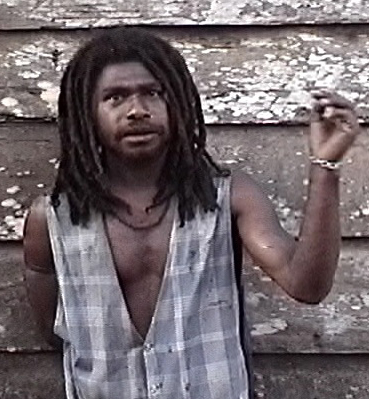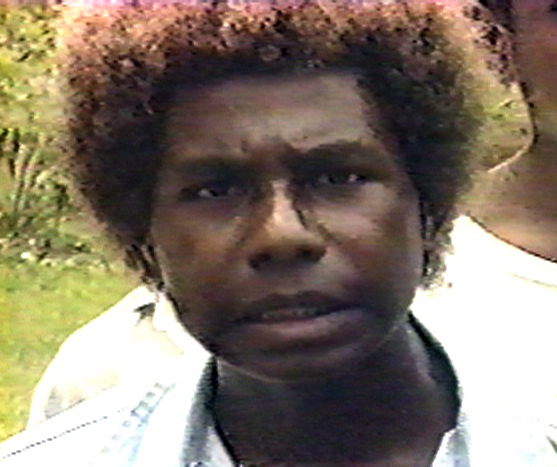Ten years ago I interviewed three natives, face to face, in a remote village on Umboi Island: Gideon Koro, Mesa Augustin, and Wesley Koro. Here is some of what I recorded of Gideon’s interview, quoted from the upcoming fourth edition of Searching for Ropens and Finding God:
I started with the basics: “Your name is Gideon Koro?”
“Yes.”
“OK. Do you remember, Gideon, about a few years ago, some Americans came with Jim Blume?”
Gideon looked puzzled.
I said, “They had a video camera.”
“Yeah.”.
“Do you remember how many years ago that was?”
“Maybe ten years ago.”
“You told them about when you went up to the mountain where there was a lake . . . big, uh, wara.” (I should have said, roun-wara for “lake.”)
Gideon nodded many times.
“All right. . . What lake was that?”
He appeared surprised at my ignorance and said, “Pung.”
“Oh, Pung, OK, Is this the first time you went to Pung or second time . . .?”
“First time.”
“Oh, the first time, OK. . . . Was this in the daytime?”
“Yeah.”.
“When you got to the lake, did you see anything right away or . . . only later? . . . Did you see anything unusual?”
I made a classic blunder in questioning someone with limited English skills: asking multiple questions at once.
Gideon paused, looking confused; then, with dawning comprehension, he said:
“No.”
Gideon took me literally: He saw nothing unusual at the moment he arrived at the lake. Arriving at an understanding of my intentions was something else.
“So did you stay there for a few minutes or an hour or . . .”
Now Gideon understood what I meant.
“A few minutes later, it came down.”.
“Oh, a few minutes later? OK. Were there some creatures that came down to the lake?” (I still thought there had been ten to twenty ropens.)
Gideon hesitated.
“. . . or animals . . . or ropen or something that came to the lake?”
Gideon nodded twice..
“Do you remember about how many there were?”
Gideon said nothing.
I said, “Uh . . . plenty . . . or ten?”
He gave me another puzzled look and said quietly:
“Only one.”“What’s that?”
“Only one.”
I said, “Only what? Oh, only one”
He then said clearly, “We saw only one.”
“Only one, OK.”
I would have to figure out that puzzle later..
“When you saw the creature . . . what color was it?”
Gideon looked away, thought for four seconds, then turned back to me:
“Brown.” (maybe the first time, outside school, he had used this English word)
“Did you notice . . . did it have wings?”
With a smile, Gideon said, “Yeah.”.
“It had wings. OK. About how large were the wings . . . like if the wings were . . .uh . . .”
Gideon was again puzzled as I tried to hold the camcorder while using one arm after another to indicate wingspan.
“. . . spread out . . . uh . . . about . . .”
Now the weakness of my impromptu interviewing style became obvious. Finally, I simply asked, “How long were the wings? Big?” A villager came to my rescue with a few words in the local village language. Only long afterwards would I realized that I had no way of knowing if the interpreter had asked about the size of one wing or two wings.
Gideon said, “Sefan meeta.” (In Tok Pisin, the plural is not formed by adding “s,” and this can carry over into their English.)
“Seven meters? OK. This animal . . . you call it a ropen? Is that the name they have for it?” (I preferred another surprise to a new misunderstanding.)
“Yeah.”.
“OK. Did it have a tail?”
“Yeah.”
“It had a tail. OK. How long was the tail?”
Gideon looked at the ground to his left for five seconds; from the way he glanced back and forth at the ground a few times, I concluded that he was imagining the tail and estimating its length. He looked back at me and said:
“Sefan meeta long.”
“Seven meters?”
“Yeah.”
“So the tail was as long as the wings?”
Without hesitation, Gideon said, “Yeah.”
 Gideon Koro, interviewed in 2004 by Jonathan Whitcomb
Gideon Koro, interviewed in 2004 by Jonathan Whitcomb
Only after my expedition in Papua New Guinea would I realize that Gideon thought that I was asking about the size of one wing. No native in a remote village on Umboi Island could be expected to understand what is meant by wingspan. He was surely thinking that I wanted to know the length of one wing. In other words, if Gideon estimated correctly, the ropen that he and his six friends had seen flying over a crater lake in clear daylight had a wingspan of over 45 feet.
Why did the two interviewers, many years earlier, conclude that Gideon and his six friends had seen ten or twenty ropens? I have come to firmly believe that it was a misunderstanding. Take the average of ten and twenty: fifteen. People in Papua New Guinea think in meters (not feet), and if Gideon was reporting a rough estimate of size (length or wingspan), in the first interview, fifteen meters is quite close to the numbers he reported to me in 2004, although I failed to communicate the concept of wingspan and neglected to ask about the total length of the ropen.
.
 Gideon Koro, interviewed around 1994 by James Blume
Gideon Koro, interviewed around 1994 by James Blume
###
Banned Wikipedia Ropen Article
There lies a weakness in Wikipedia, although a solution seems hard to come by. When proponents of the “mainstream view” on a subject seem reluctant to state their orthodox opinions, in sufficient content-size, a fringe theory can appear to be unbalanced in an article, favoring too much an unpopular point of view.
.


